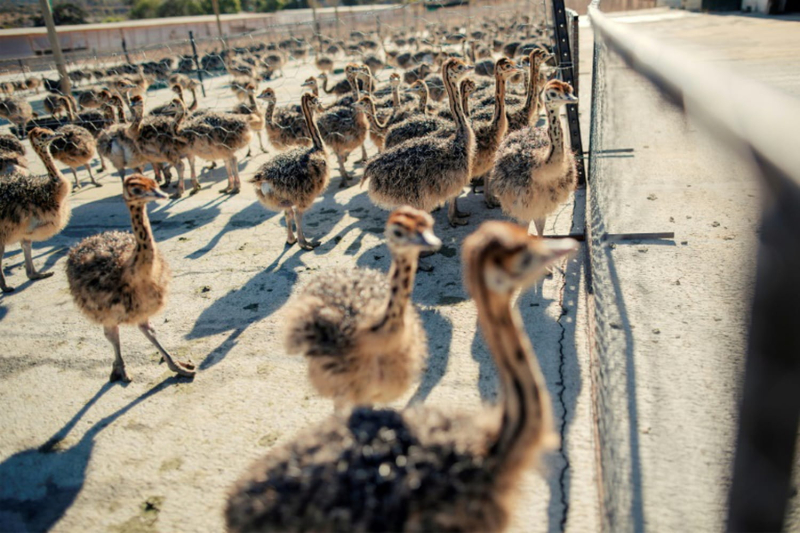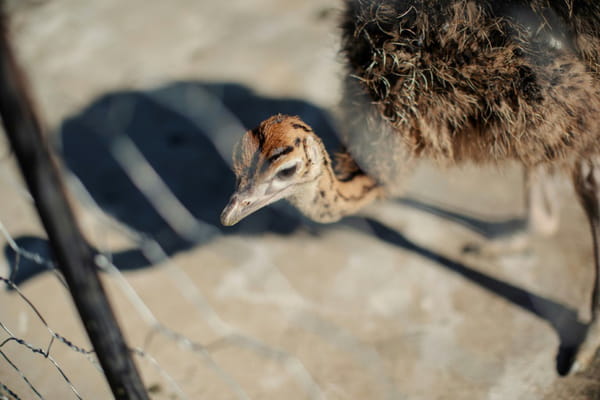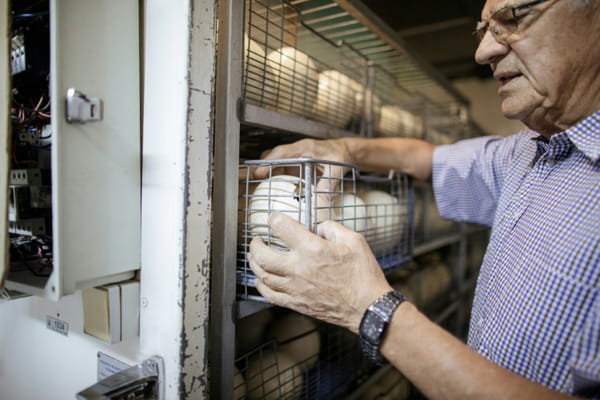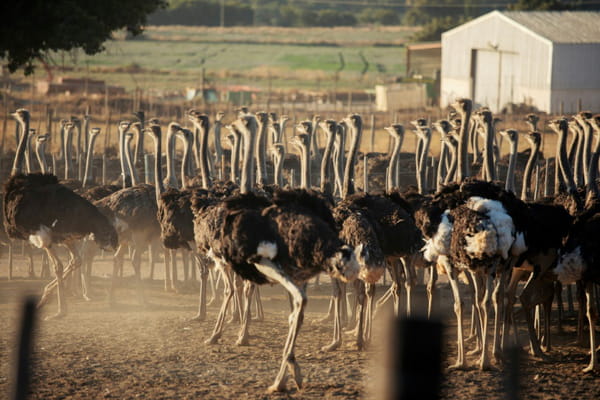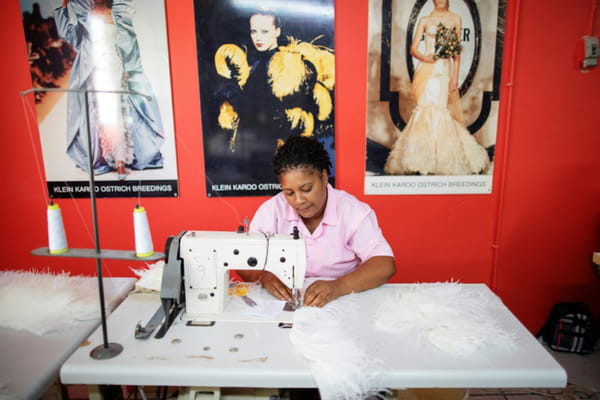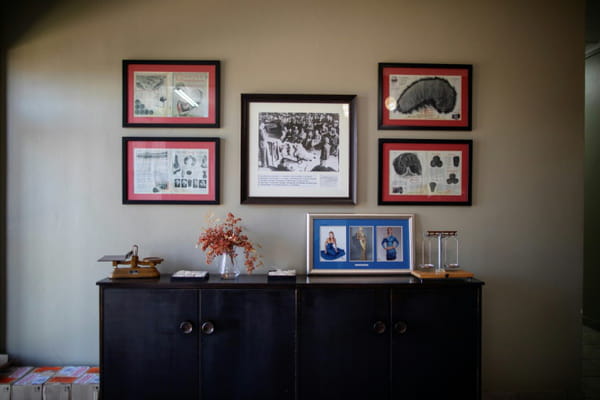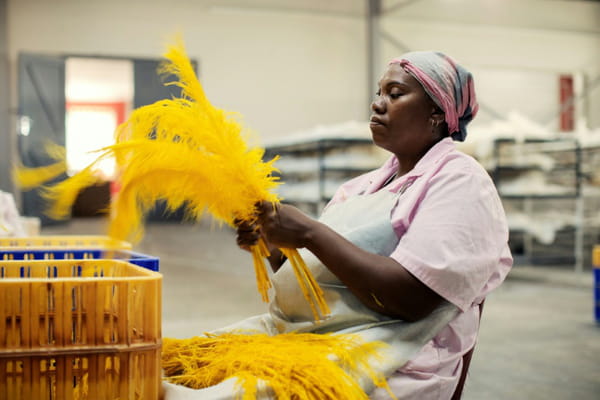In the golden light of the setting sun, Saag Jonker extends his arm towards the juvenile ostriches which approach with curiosity. Nearly 400 birds stretch their slender necks to the sky. across the enclosure, shaking their feathers in a cloud of ocher dust. “This male has beautiful plumage. As an adult, he will reach 125 kilos”, smiles the 82-year-old South African breeder, pointing to an animal with black and white plumes. On the dirt road leading to his farm, ostrich farms follow one another. This valley of the Little Karoo with its rough landscape, between two mountain ranges along the southern coast of the country, is the “ostrich capital of the world”. From a simple duster for dusting to luxury ready-to-wear, 70% of ostrich products come from South Africa, mainly from this area with an ideal arid climate. A young ostrich in an enclosure on one of the farms of breeder Saag Jonker, February 13, 2024 in Oudtshoorn, South Africa © AFP – GIANLUIGI GUERCIA In the streets of the capital of Oudtshoorn, the giant bird is omnipresent. Its tender red meat appears on all menus. The windows display ostrich leather bags, recognizable by the “pearls” left by the implantation of the feathers. A sign welcomes visitors with a “May the feathers be with you.” – Red carpet – In his office where a large cream-colored egg sits, Saag Jonker, born in a modest family, says he joined the sector as a “feather auctioneer” at the age of 22. Breeder Saag Jonker inspects ostrich eggs on one of his farms on February 13, 2024 in Oudtshoorn, South Africa. © AFP – GIANLUIGI GUERCIA Sixty years later, he is at the head of an empire: the largest private ostrich breeding, processing and marketing company in the world, with nearly 45,000 birds slaughtered per season . “We produce 60% of the region’s chicks,” he emphasizes. In her hatchery, the squawking of hundreds of newborn ostriches drowns out the soft crackle of hatching eggs. With an expert hand, a worker opens the temperature-controlled drawers and removes a few pieces of shell, revealing a small, delicate beak and a still dozing eye. Ostriches in an enclosure on one of the farms of breeder Saag Jonker, February 13, 2024 in Oudtshoorn, South Africa © AFP – GIANLUIGI GUERCIA As an adult, an ostrich produces around a kilo of feathers, which are then sterilized and sorted. The most popular – the large black and white plumes on the wings – are sold all over the world, from the Moulin Rouge to the Rio carnival, including haute couture houses. “A good exposure of our products” is visible on the red carpet of the Met Gala evening in New York, explains Peter Liebenberg, 52, head of feathers at Cape Karoo International, one of the market leaders. In the processing factory in Oudtshoorn, 200 workers sort, cut, wash and dye the feathers in several hundred colorful colors. A seamstress from the Cape Karoo company works on ostrich feathers, February 13, 2024 in Oudtshoorn, South Africa © AFP – GIANLUIGI GUERCIA Installed under images of Balmain, Paco Rabanne or Jean Paul Gaultier fashion shows, around ten seamstresses in pink uniforms work delicate fringes. Long multi-colored boas rest on the tables. The company sells around a hundred tonnes of feathers each year, explains Peter Liebenberg. – Golden Age – At the entrance to the factory, black and white photos recall the golden age of Oudtshoorn. Photos of the history of the ostrich feather trade hang on the wall of the Cape Karoo company's factory on February 13, 2024 in Oudtshoorn, South Africa © AFP – GIANLUIGI GUERCIA At the start of the 20th century, ostrich feathers were the fourth largest South African export. In Europe, the fashion was for hats decorated with sumptuous feathers. Dozens of “ostrich barons” are making fortunes. Feathers are then worth more, by weight, than gold. In 1911, these breeders offered the Queen of England a dazzling fan woven with white feathers, a symbol of their prosperity. But three years later, the business collapsed. The First World War and its disruption of international maritime trade coincided with the popularization of the car. “Impossible to get into a convertible with a hat adorned with a feather!”, relates Peter Liebenberg. A seamstress from the Cape Karoo company works on ostrich feathers, February 13, 2024 in Oudtshoorn, South Africa © AFP – GIANLUIGI GUERCIA Over the decades, the industry reinvented itself by focusing in particular on other derivative products: luxury leather, meat and even eggs, sculpted into decorative objects or lampshades. Feathers “always come back”, specifies Peter Liebenberg, welcoming the “excellent prices” achieved for the sale of “fashion products, carnival, dusting”. During the Covid-19 pandemic, the entertainment market collapsed but the demand for dusters “exploded”, recalls- he smiled amusedly: “All the confined people wanted to clean.” All rights of reproduction and representation reserved. © (2024) Agence France-Presse